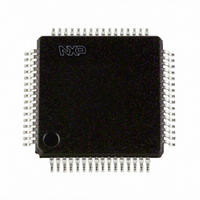LPC2194HBD64/01,15 NXP Semiconductors, LPC2194HBD64/01,15 Datasheet - Page 20

LPC2194HBD64/01,15
Manufacturer Part Number
LPC2194HBD64/01,15
Description
IC ARM7 MCU FLASH 256K 64-LQFP
Manufacturer
NXP Semiconductors
Series
LPC2100r
Datasheet
1.LPC2194HBD640115.pdf
(40 pages)
Specifications of LPC2194HBD64/01,15
Program Memory Type
FLASH
Program Memory Size
256KB (256K x 8)
Package / Case
64-LQFP
Core Processor
ARM7
Core Size
16/32-Bit
Speed
60MHz
Connectivity
CAN, I²C, Microwire, SPI, SSI, SSP, UART/USART
Peripherals
POR, PWM, WDT
Number Of I /o
46
Ram Size
16K x 8
Voltage - Supply (vcc/vdd)
1.65 V ~ 3.6 V
Data Converters
A/D 4x10b
Oscillator Type
Internal
Operating Temperature
-40°C ~ 125°C
Processor Series
LPC21
Core
ARM7TDMI-S
Data Bus Width
16 bit, 32 bit
Data Ram Size
16 KB
Interface Type
CAN/I2C/SPI/UART
Maximum Clock Frequency
60 MHz
Number Of Programmable I/os
46
Number Of Timers
2
Operating Supply Voltage
3.3 V
Maximum Operating Temperature
+ 125 C
Mounting Style
SMD/SMT
3rd Party Development Tools
MDK-ARM, RL-ARM, ULINK2
Minimum Operating Temperature
- 40 C
On-chip Adc
4-ch x 10-bit
Lead Free Status / RoHS Status
Lead free / RoHS Compliant
For Use With
568-4310 - EVAL BOARD LPC2158 W/LCD568-4297 - BOARD EVAL LPC21XX MCB2100622-1005 - USB IN-CIRCUIT PROG ARM7 LPC2K
Eeprom Size
-
Lead Free Status / Rohs Status
Lead free / RoHS Compliant
Other names
568-4316
935284881151
LPC2194HBD64/01-S
LPC2194HBD64/01-S
935284881151
LPC2194HBD64/01-S
LPC2194HBD64/01-S
Available stocks
Company
Part Number
Manufacturer
Quantity
Price
Company:
Part Number:
LPC2194HBD64/01,15
Manufacturer:
Maxim
Quantity:
60
Company:
Part Number:
LPC2194HBD64/01,15
Manufacturer:
NXP Semiconductors
Quantity:
10 000
Part Number:
LPC2194HBD64/01,15
Manufacturer:
NXP/恩智浦
Quantity:
20 000
NXP Semiconductors
LPC2194_5
Product data sheet
6.18.3 Reset and wake-up timer
6.18.4 Code security (Code Read Protection - CRP)
by 2, 4, 8, or 16 to produce the output clock. Since the minimum output divider value is 2,
it is insured that the PLL output has a 50 % duty cycle. The PLL is turned off and
bypassed following a chip Reset and may be enabled by software. The program must
configure and activate the PLL, wait for the PLL to Lock, then connect to the PLL as a
clock source. The PLL settling time is 100 s.
Reset has two sources on the LPC2194: the RESET pin and Watchdog Reset. The
RESET pin is a Schmitt trigger input pin with an additional glitch filter. Assertion of chip
Reset by any source starts the Wake-up Timer (see Wake-up Timer description below),
causing the internal chip reset to remain asserted until the external Reset is de-asserted,
the oscillator is running, a fixed number of clocks have passed, and the on-chip flash
controller has completed its initialization.
When the internal Reset is removed, the processor begins executing at address 0, which
is the Reset vector. At that point, all of the processor and peripheral registers have been
initialized to predetermined values.
The Wake-up Timer ensures that the oscillator and other analog functions required for
chip operation are fully functional before the processor is allowed to execute instructions.
This is important at power on, all types of Reset, and whenever any of the aforementioned
functions are turned off for any reason. Since the oscillator and other functions are turned
off during Power-down mode, any wake-up of the processor from Power-down mode
makes use of the Wake-up Timer.
The Wake-up Timer monitors the crystal oscillator as the means of checking whether it is
safe to begin code execution. When power is applied to the chip, or some event caused
the chip to exit Power-down mode, some time is required for the oscillator to produce a
signal of sufficient amplitude to drive the clock logic. The amount of time depends on
many factors, including the rate of V
and its electrical characteristics (if a quartz crystal is used), as well as any other external
circuitry (e.g., capacitors), and the characteristics of the oscillator itself under the existing
ambient conditions.
This feature of the LPC2194/01 allows the user to enable different levels of security in the
system so that access to the on-chip flash and use of the JTAG and ISP can be restricted.
When needed, CRP is invoked by programming a specific pattern into a dedicated flash
location. IAP commands are not affected by the CRP.
There are three levels of the Code Read Protection.
CRP1 disables access to chip via the JTAG and allows partial flash update (excluding
flash sector 0) using a limited set of the ISP commands. This mode is useful when CRP is
required and flash field updates are needed but all sectors can not be erased.
CRP2 disables access to chip via the JTAG and only allows full flash erase and update
using a reduced set of the ISP commands.
Running an application with level CRP3 selected fully disables any access to chip via the
JTAG pins and the ISP. This mode effectively disables ISP override using P0[14] pin, too. It
is up to the user’s application to provide (if needed) flash update mechanism using IAP
calls or call reinvoke ISP command to enable flash update via UART0.
Rev. 05 — 10 December 2007
DD
ramp (in the case of power on), the type of crystal
Single-chip 16/32-bit microcontroller
LPC2194
© NXP B.V. 2007. All rights reserved.
20 of 40
















